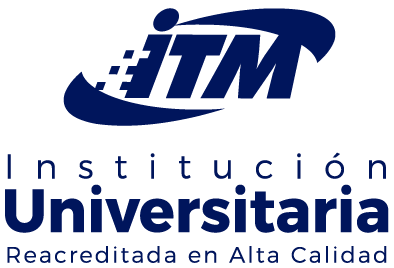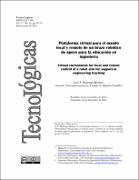| dc.contributor.author | Buitrago-Molina, José T. | |
| dc.contributor.author | Carvajal-Guerrero, Juan S. | |
| dc.contributor.author | Zapata-Castillo, Camilo A. | |
| dc.date.accessioned | 2019-07-18T14:10:21Z | |
| dc.date.accessioned | 2019-08-20T15:48:11Z | |
| dc.date.available | 2019-07-18T14:10:21Z | |
| dc.date.available | 2019-08-20T15:48:11Z | |
| dc.date.issued | 2014-01-15 | |
| dc.identifier | https://revistas.itm.edu.co/index.php/tecnologicas/article/view/206 | |
| dc.identifier | 10.22430/22565337.206 | |
| dc.identifier.uri | http://hdl.handle.net/20.500.12622/936 | |
| dc.description.abstract | En este artículo se presenta el diseño e implementación de una plataforma virtual, que permite la simulación y mando local y remoto del brazo robot tipo SCARA llamado UV-CERMA, presente en el Laboratorio de Robótica de la Escuela de Ingeniería Eléctrica y Electrónica de la Facultad de Ingeniería de la Universidad del Valle, el robot UV-CERMA ha estado subutilizado desde hace algunos años debido a lo obsoleto de su sistema de control. La plataforma, enfocada con los lineamientos de educación en ingeniería está compuesta por dos aplicaciones que permiten la simulación y el mando y control locales y remotos para el robot, una de las aplicaciones se programó haciendo uso del paquete de National Instruments LabVIEW y la otra aplicación se realizó por medio de software libre, por medio del lenguaje de código abierto Java, ambos desarrollos implementan los modelos cinemático directo y cinemático inverso, un módulo para la planificación y ejecución de trayectorias, otro módulo para el monitoreo de variables y un modelo 3D del robot. Para la manipulación del robot se tiene una interfaz con un joystick, que lo hace más versátil. Las aplicaciones se comunican al robot real mediante una tarjeta de adquisición de datos de National Instruments NI USB-6211, y para el mando remoto la plataforma cuenta con una arquitectura cliente/servidor usando sockets TCP/IP. | spa |
| dc.format.mimetype | application/pdf | |
| dc.language.iso | spa | |
| dc.publisher | Instituto Tecnológico Metropolitano (ITM) | spa |
| dc.relation | https://revistas.itm.edu.co/index.php/tecnologicas/article/view/206/212 | |
| dc.rights | Copyright (c) 2017 Tecno Lógicas | spa |
| dc.source | 2256-5337 | |
| dc.source | 0123-7799 | |
| dc.source | TecnoLógicas; Vol. 17 Num. 32 (2014); 67-74 | eng |
| dc.source | TecnoLógicas; Vol. 17 Num. 32 (2014); 67-74 | spa |
| dc.subject | Interfaz | spa |
| dc.subject | plataforma virtual | spa |
| dc.subject | brazo robot | spa |
| dc.subject | Java | spa |
| dc.subject | LabVIEW | spa |
| dc.title | Plataforma virtual para el mando local y remoto de un brazo robótico de apoyo para la educación en ingeniería | spa |
| dc.title.alternative | Virtual environment for local and remote control of a robot arm for support in engineering teaching | |
| dc.subject.keywords | Interface | eng |
| dc.subject.keywords | Java | eng |
| dc.subject.keywords | LabVIEW | eng |
| dc.subject.keywords | robot arm | eng |
| dc.subject.keywords | virtual platform. | eng |
| dc.type | info:eu-repo/semantics/article | |
| dc.type | info:eu-repo/semantics/publishedVersion | |
| dc.type | Research Papers | eng |
| dc.type | Artículos de investigación | spa |
| dc.relation.ispartofjournal | TecnoLógicas | |
| dc.description.abstractenglish | This paper presents the design and implementation of a virtual platform that allows simulation and local and remote command and control of the SCARA robot arm called UV-CERMA, which is installed at the Robotics Laboratory of the Escuela de Ingeniería Eléctrica y Electrónica, Facultad de Ingeniería, Universidad del Valle. The robot has been underutilized for some years due to the obsolete control system. The platform, focused on the engineering education methodology, consists of two applications which simulate the robot and permit its remote and local command and control. One of the applications was implemented on LabVIEW software of National Instruments and the other application was programmed on free software using the open source language Java. Both applications implement forward kinematics and inverse kinematics, have a module for trajectories planning and operation, a module for monitoring the values of the variables and a three dimensional model of the robot. To manipulate the robot, an interface with a joystick was developed, enhancing the versatility of the platform. The applications communicate with the real robot using the National Instruments data acquisition card NI USB-6211, and for the remote connection they have a client-server architecture using TCP/IP sockets. | eng |
| dc.rights.accessrights | info:eu-repo/semantics/openAccess | |
| dc.type.coar | http://purl.org/coar/resource_type/c_6501 | |


